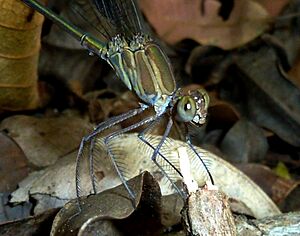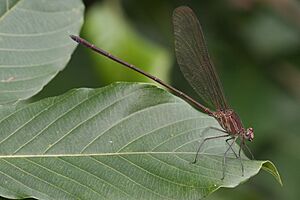Glistening demoiselle facts for kids
Quick facts for kids Glistening demoiselle |
|
|---|---|
 |
|
| male | |
 |
|
| female | |
| Conservation status | |
| Scientific classification | |
| Genus: |
Phaon
|
| Species: |
iridipennis
|
| Synonyms | |
|
|
Phaon iridipennis, often called the glistening demoiselle, is a beautiful type of damselfly. It belongs to the Calopterygidae family. This amazing insect gets its name from its wings, which sparkle with purple-blue colors in the sunlight. It is a common sight in many parts of Africa.
Contents
What Does It Look Like?
The Glistening Demoiselle is a large damselfly. It can grow up to 75 mm (about 3 inches) long. Its wingspan can reach 87 mm (about 3.4 inches). It also has long legs.
Its wings are special because they are iridescent. This means they shimmer and change color, like a rainbow, when light hits them. They often show purple-blue sparkles. As the damselfly gets older, its wings might look a bit smoky.
Sometimes, these damselflies have small, colored spots on their wings called pterostigmata. These spots start as light brown. They get darker as the damselfly ages. Both male and female damselflies have a coppery green body. However, females usually look a bit duller and browner than males.
Where Does It Live?
The Glistening Demoiselle is found in many places. It lives across most of sub-Saharan Africa. You can find it from South Africa all the way to Ethiopia and Senegal. It is especially common in warmer, tropical areas. It also lives on the island of Madagascar.
Preferred Homes
This damselfly loves to live near rivers and streams. It prefers places with lots of trees forming a "gallery forest" over the water. It also lives in coastal forests, dune forests, and swamp forests. You might also see it at the edges of ponds and marshes that have trees.
It really needs shady spots. You will rarely see it flying out in bright, open sunlight. However, it can sometimes be found in more open areas within a forest.
How Does It Behave?
You can spot the Glistening Demoiselle all year round in warmer regions. But it is most active from October to March. Its busiest time is usually in late November.
When this damselfly rests, it holds its wings at a 45-degree angle. Its abdomen, or tail part, is slightly raised. It is very hard to see when it is perched. This is because its colors help it blend in with its surroundings. But when it flies, it is very noticeable. Its large size and sparkling wings make it easy to spot.
Where to Find Them
Near water, it likes to perch low down. It will sit on rocks or on sticks that hang over the water. However, you can often find it far from water too. It likes to hide in the dense, shady undergrowth of forests. This is especially true later in the season. They usually perch on sticks and logs among fallen leaves. They are normally found within 2 meters (about 6.5 feet) of the ground.
Conservation Status
The Glistening Demoiselle is doing well. The IUCN lists it as a least concern species. This means it is not currently at risk of disappearing. It can handle some changes to its home, like changes in water clarity. It can also tolerate some non-native plants growing in its habitat.


